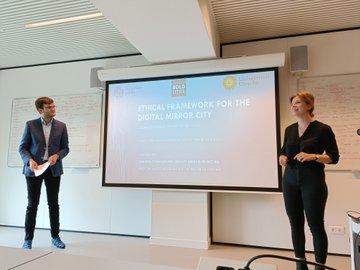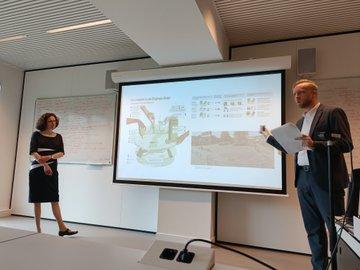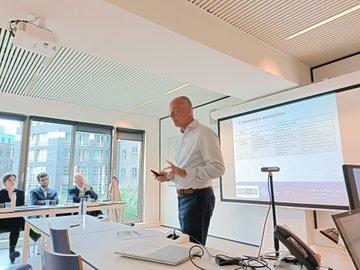Last week, the Centre for BOLD Cities organised a mini lunch symposium on urban digital twins for researchers, students and civil servants. Three research groups connected to the Centre talked about their research on digital twins in the municipal context.
An ethical framework for the digital mirror city
 To kick off, Brecht Weerheijm (Leiden University) and Carmen Dymanus (Utrecht University) gave a presentation about the ethical framework they developed together with the municipality of The Hague for its digital twin: the digital mirror city, under lead of prof. dr. ir. Bram Klievink and prof. dr. Albert Meijer.
To kick off, Brecht Weerheijm (Leiden University) and Carmen Dymanus (Utrecht University) gave a presentation about the ethical framework they developed together with the municipality of The Hague for its digital twin: the digital mirror city, under lead of prof. dr. ir. Bram Klievink and prof. dr. Albert Meijer.
Weerheijm and Dymanus emphasized the importance of developing a framework that both allows for discussion and conversation as well as clear guidance on next steps. Through interviews and co-design sessions with civil servant, they also ensured that the framework corresponds to the real-life ethical challenges civil servants face and the values they find important.
Weerheijm and Dymanus identified four different categories and 12 central public values that need to be taken into account when implementing smart solutions. In a traffic light model, civil servants can then assess whether and to what extent these values are impacted. They are then asked to explicitly formulate the risks – in a team – and devise concrete and actionable policies to safeguard those values. Each assessment ends with a ‘checklist’, providing clear guidance on whether to go ahead.
Through an illustrative case, the participants got to try out the model themselves. In small groups, they had to discuss the impact of a fully automated crowd safety manager – that could for example automatically close roads – on the public values of transparency, privacy and human autonomy and propose actions to mitigate that effect. Lively discussions ensued!
Want to find out more about the ethical framework? Please contact Brecht Weerheijm (b.weerheijm@fgga.leidenuniv.nl) or Carmen Dymanus (c.e.dymanus@uu.nl) .
Not all twins are identical
In the second presentation, dr. Carola van Eijk (Leiden University) and dr. Thomas Swerts (Erasmus University) outlined their BOLD Cities team science project TWIRL (digital TWIns as Regimes of visibiLity) and shared preliminary findings.
Urban Digital Twins (UDTs) are very topical and ‘trendy’ among municipalities. Yet, many questions remain unclear: what information is included and what information is excluded? Who can participate and for what purpose? How can UDTs contribute to decision making? The overarching aim of their research is to provide (digital) visibility and voice in the city to those who have none. Unique about the project is the close connection between practice, research and education, with master students being actively involved in the research.
 The research focusses on Rotterdam’s already existing digital twin and The Hague’s developing digital twin and employs different methods: from in-depth interviews to surveys, document analysis and field labs. Additionally, the team aspires to concretely contribute to the design and development of an urban digital twin that allows for the inclusion of digitally underrepresented communities through speculative design and experimental labs.
The research focusses on Rotterdam’s already existing digital twin and The Hague’s developing digital twin and employs different methods: from in-depth interviews to surveys, document analysis and field labs. Additionally, the team aspires to concretely contribute to the design and development of an urban digital twin that allows for the inclusion of digitally underrepresented communities through speculative design and experimental labs.
Swerts went on to share some more preliminary findings from their interviews in Rotterdam and the programme ‘Digital City’ by the municipality of Rotterdam. Interviewees shared technological challenges (such as the quality of data) but also socio-technological challenges were seen as challenges for realizing the digital twin. These include the coordination of stakeholders of the digital twin (of which they are many!), the different speeds at which they work but also the digital divide. Additionally, there are concerns about how the reality of a city will be translated to a digital environment. Or in the words of one interviewee: “Will there be rats in the digital city?”
If you want to find out more about this research project, please do not hesitate to contact Carola van Eijk c.j.a.van.eijk@fgga.leidenuniv.nl or Thomas Swerts swerts@essb.eur.nl or consult their website: Urban Digital Twins | Centre for BOLD Cities (centre-for-bold-cities.nl)
Digital Twin in an Urban environment
 Last but not least, prof. dr. Roland Ortt (Erasmus University/TU Delft) shared his research outcomes about the embedding of digital twins in four different municipalities in the Netherlands.
Last but not least, prof. dr. Roland Ortt (Erasmus University/TU Delft) shared his research outcomes about the embedding of digital twins in four different municipalities in the Netherlands.
Going back to the definition of digital twins, Ortt distinguishes between four different levels of digital twins. These can range from a 3D-model, to a digital twin that not only simulates (level 2), but processes real-life data (level 3) and allows for control (level 4).
One of the main challenges encountered by Ortt in his interviews with professionals, is the (lack of) political embedding. Many of the initiatives related to digital twins are on project and pilot basis (i.e. temporally funded) rather than being politically approved and guaranteed funding over a longer period of time. This impacts the adaption process for digital twins.
Ortt outlines the importance of choosing the lowest level of digital twin required for the stakeholder’s – that is the citizen’s – need. While in order to prevent traffic jams, a level three or four digital twin is necessary, to coordinate maintenance of underground cables only requires a level one or two digital twin. Making this decision from the stakeholder’s needs also allows for broader political support.
For more information about Roland Ortt’s, contact him at j.r.ortt@tudelft.nl.
